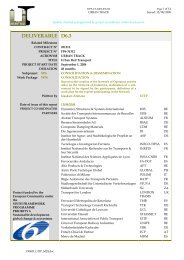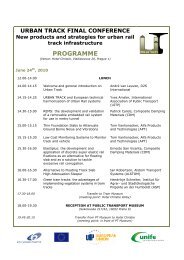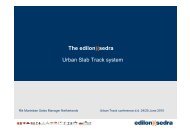DELIVERABLE 2.8 - urban track
DELIVERABLE 2.8 - urban track
DELIVERABLE 2.8 - urban track
Create successful ePaper yourself
Turn your PDF publications into a flip-book with our unique Google optimized e-Paper software.
D0208_STIB_M24.doc<br />
TIP5-CT-2006-031312 Page 25 of 44<br />
URBAN TRACK Issued: August 13, 2008<br />
Quality checked and approved by project co-ordinator André Van Leuven<br />
3.2. BASIS OF ATM – CURVE, COMPARISON OF KINEMATICS AND DYNAMICS<br />
Figure 3.2<br />
The main difference between the standard curve (clothoid) and the Viennese Curve is in the advanced<br />
line management. The advantages of the modern geometry are obviously. The centre of gravity<br />
guidance of the vehicle is optimised and has very low and continuous accelerations and low guiding<br />
forces. The <strong>track</strong> is continuously defined while its loading is minimal and known. The <strong>track</strong> alignment<br />
height is based on the centre of gravity. Due to the smooth ramp, transition low decay rates of the <strong>track</strong><br />
are expected and demonstrated.<br />
The following picture shows the curve driving powers which affect the <strong>track</strong> and the vehicle and due the<br />
passengers.<br />
Curve Driving Powers at the drive over a curved <strong>track</strong><br />
The transition curves used so far had straight cant gradients. The impact of substantial forces at these<br />
transitions has resulted in greater rail and wheel wear. Such conventional transitions also reduce the<br />
passengers’ ride comfort and safety by causing noticeable transverse jerks. In addition, such areas<br />
frequently develop <strong>track</strong> geometry defects.<br />
The Viennese Transition Curve provides for a verifiable reduction of rail wear in curves and for an<br />
extended life cycle in comparison with a conventional alignment geometry based on clothoid and straight<br />
cant gradients. Moreover, the new design feature improves the accuracy of <strong>track</strong> position. The advanced<br />
<strong>track</strong> alignment used for the Viennese Transition Curve is the key to maintaining the desired <strong>track</strong><br />
geometry. This in turn will extend the life cycle and reduce life cycle costs. In addition, the constant and<br />
non-jerking movement of vehicles obtained in curves will greatly improve passengers’ riding comfort<br />
and safety.








